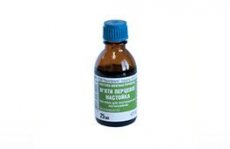Medical expert of the article
New publications
Preparations
Peppermint tincture
Last reviewed: 03.07.2025

All iLive content is medically reviewed or fact checked to ensure as much factual accuracy as possible.
We have strict sourcing guidelines and only link to reputable media sites, academic research institutions and, whenever possible, medically peer reviewed studies. Note that the numbers in parentheses ([1], [2], etc.) are clickable links to these studies.
If you feel that any of our content is inaccurate, out-of-date, or otherwise questionable, please select it and press Ctrl + Enter.

The healing properties of peppermint tincture have been known since ancient times. References to this herb of the Lamiaceae family can be found in ancient Egyptian mythology. There is even an ancient Greek mythical legend about its origin. It says that this plant was named after the beloved nymph of the ruler of the underworld Hades - Menta. Hades' wife, having learned of her husband's betrayal, turned Menta into a plant with a pleasant, strong aroma.
 [ 1 ]
[ 1 ]
Indications peppermint tincture
Peppermint tincture affects various body systems. On the part of the nervous system, it has a mild sedative effect, which is why it is used in combination therapy for depression, insomnia, nervous disorders, severe manifestations of premenstrual syndrome and menopause. On the part of the digestive system, this drug has choleretic, antiseptic and antispasmodic properties, which allows it to be used for peptic ulcers, intestinal and hepatic colic, flatulence, as well as sudden attacks of nausea during toxicosis and seasickness. On the part of the respiratory system, this medicine has an antispasmodic property, which allows it to be used in the treatment of asthma, chronic bronchitis and other sluggish respiratory diseases. On the part of the cardiovascular system, this drug has a calming, antispasmodic and relaxing effect, due to these properties it is included in the composition of cardiac drugs (validol, valocordin and others). This remedy also has an antibacterial and immune system stimulating effect, which is why it is used for colds, as well as a local anti-inflammatory pain reliever.
Release form
Most often, peppermint tincture is used as an auxiliary substance, imparting flavor and aroma in medicinal syrups and tablets. But it can also be purchased separately. Peppermint tincture is available in dark glass bottles, 25 ml each, enclosed in cardboard packaging. One bottle contains 1.25 ml of peppermint essential oil and ethanol alcohol. The liquid has a green color and a characteristic mint aroma.
Pharmacodynamics
The effect of this drug is due to the presence of a large amount of menthol. Menthol has an antiemetic, antiseptic and analgesic effect. Menthol also has a moderate sedative, carminative, antianginal and antihypoxic effect. Due to the ability to affect the cold receptors in the mouth, peppermint tincture stimulates the release of endorphins, dynorphins and enkephalins, which leads to a decrease in the sensation of pain. At the same time, vasodilation and a decrease in blood pressure also occur. When using this drug, a reflex irritation of the respiratory system occurs, which has a positive effect on ventilation of the lungs. When peppermint tincture enters the gastrointestinal tract, smooth muscles relax, which leads to an increase in the outflow of bile, increased production of gastric juice, easier evacuation of food from the intestines, and also indirectly affects the genitourinary system. When applied externally, it has antiseptic and tanning properties.
Dosing and administration
Peppermint tincture is usually prescribed to be taken orally in drops - 10-15 drops 3-4 times a day before meals. For children over 12 years old, the dosage is calculated at 1 drop per 1 year of life. This drug is also used for rinsing the mouth, local lotions and inhalations. The dosage in this case is selected individually.
Use peppermint tincture during pregnancy
During pregnancy, this medicine can be used in small doses, but in large doses, it is highly not recommended. During breastfeeding, this medicine can have a depressing effect on the production of breast milk.
Contraindications
It is not recommended to use this medicine for people with polyvalent allergies, individual intolerance to the components of the drug, patients with severe bronchial asthma, as well as breastfeeding women. It is highly inadvisable to use the drug for children under 12 years of age and pregnant women (in large doses). Since the drug contains ethanol alcohol, it is highly inadvisable to use it for drivers, as well as precision machine operators.
Side effects peppermint tincture
Side effects are extremely rare when using this drug. The most common side effects may be:
- from the respiratory system: bronchospasm. Respiratory depression;
- from the gastrointestinal tract: nausea, vomiting;
- from the nervous system: dizziness, drowsiness;
- when applied locally: rash, swelling and redness of the skin, itching.
Storage conditions
The drug should be stored in a dark place, protected from direct sunlight, at room temperature and a relative humidity of no more than 75%.
 [ 16 ]
[ 16 ]
Special instructions
Making tincture at home
For this we will need:
- chopped mint leaf – 1 part;
- peppermint essential oil – 1 part;
- alcohol 70% - 20 parts.
Pour crushed fresh mint leaves with alcohol, leave for 24 hours, shaking occasionally. Then strain and add mint essential oil.
Attention!
To simplify the perception of information, this instruction for use of the drug "Peppermint tincture" translated and presented in a special form on the basis of the official instructions for medical use of the drug. Before use read the annotation that came directly to medicines.
Description provided for informational purposes and is not a guide to self-healing. The need for this drug, the purpose of the treatment regimen, methods and dose of the drug is determined solely by the attending physician. Self-medication is dangerous for your health.

